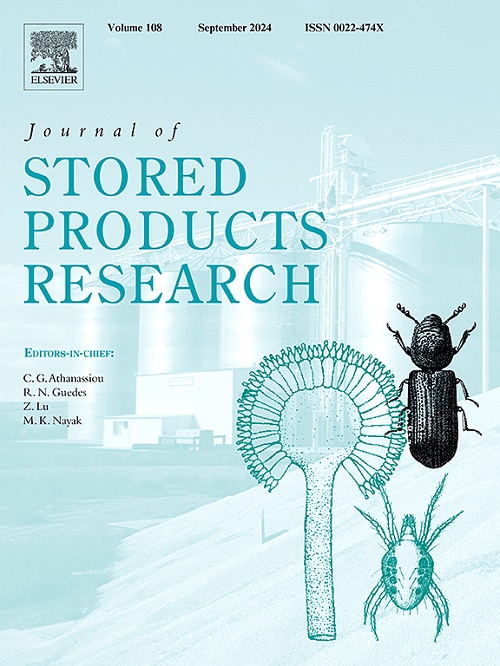Storage stability and packaging impact on spray-dried encapsulated Sesbania flower extract during long-term storage
IF 2.7
2区 农林科学
Q1 ENTOMOLOGY
引用次数: 0
Abstract
This study investigated the storage stability of spray-dried Sesbania flower extract (SFE) under different packaging conditions over six months. Microencapsulation was performed using gum arabic (GA), resistant maltodextrin (RMD), and their combination (RMDGA) at 150 °C and 160 °C, with GA at 160 °C identified as the optimal condition. The microcapsules exhibited high retention of total phenolic content (TPC) (16.86 mg GAE/g db), total flavonoid content (TFC) (3.29 mg QE/g db), and antioxidant activities (DPPH: 24.63 μM Trolox/g db; FRAP: 39.01 μM Trolox/g db), significantly higher than in other formulations (p ≤ 0.05). The effects of vacuum-sealed and normal-sealed aluminum and HDPE packaging were assessed during six-month storage. Vacuum-sealed aluminum bags provided the best protection, with TPC, TFC, DPPH, and FRAP retention of 70.5%, 51.4%, 53.2%, and 72.2%, respectively (p ≤ 0.05), while solubility and color remained stable. In contrast, HDPE packaging led to greater moisture absorption and faster bioactive degradation. Microbiological analysis confirmed the absence of pathogenic microorganisms, including Salmonella spp., Listeria monocytogenes, and Staphylococcus aureus, ensuring product safety during storage. This study highlights the importance of optimized packaging in maintaining bioactivity and extending the shelf life of encapsulated plant extracts for functional food applications.
喷雾干燥包封田葵花提取物长期贮存稳定性及包装影响
研究了喷雾干燥田菁花提取物(SFE)在不同包装条件下的贮存稳定性。采用阿拉伯胶(GA)、耐药麦芽糊精(RMD)及其组合(RMDGA)在150℃和160℃进行微胶囊化,以160℃的GA为最佳条件。微胶囊具有较高的总酚含量(TPC) (16.86 mg GAE/g db)、总黄酮含量(TFC) (3.29 mg QE/g db)和抗氧化活性(DPPH: 24.63 μM Trolox/g db);FRAP: 39.01 μM Trolox/g db),显著高于其他配方(p≤0.05)。在六个月的储存期间,评估了真空密封和正常密封铝和HDPE包装的效果。真空密封铝袋保护效果最好,TPC、TFC、DPPH、FRAP保留率分别为70.5%、51.4%、53.2%、72.2% (p≤0.05),溶解度和颜色保持稳定。相比之下,HDPE包装导致更大的吸湿性和更快的生物活性降解。微生物学分析证实不含致病性微生物,包括沙门氏菌、单核增生李斯特菌和金黄色葡萄球菌,确保了产品在储存期间的安全性。本研究强调了优化包装在保持功能性食品中胶囊化植物提取物的生物活性和延长保质期方面的重要性。
本文章由计算机程序翻译,如有差异,请以英文原文为准。
求助全文
约1分钟内获得全文
求助全文
来源期刊
CiteScore
5.70
自引率
18.50%
发文量
112
审稿时长
45 days
期刊介绍:
The Journal of Stored Products Research provides an international medium for the publication of both reviews and original results from laboratory and field studies on the preservation and safety of stored products, notably food stocks, covering storage-related problems from the producer through the supply chain to the consumer. Stored products are characterised by having relatively low moisture content and include raw and semi-processed foods, animal feedstuffs, and a range of other durable items, including materials such as clothing or museum artefacts.

 求助内容:
求助内容: 应助结果提醒方式:
应助结果提醒方式:


